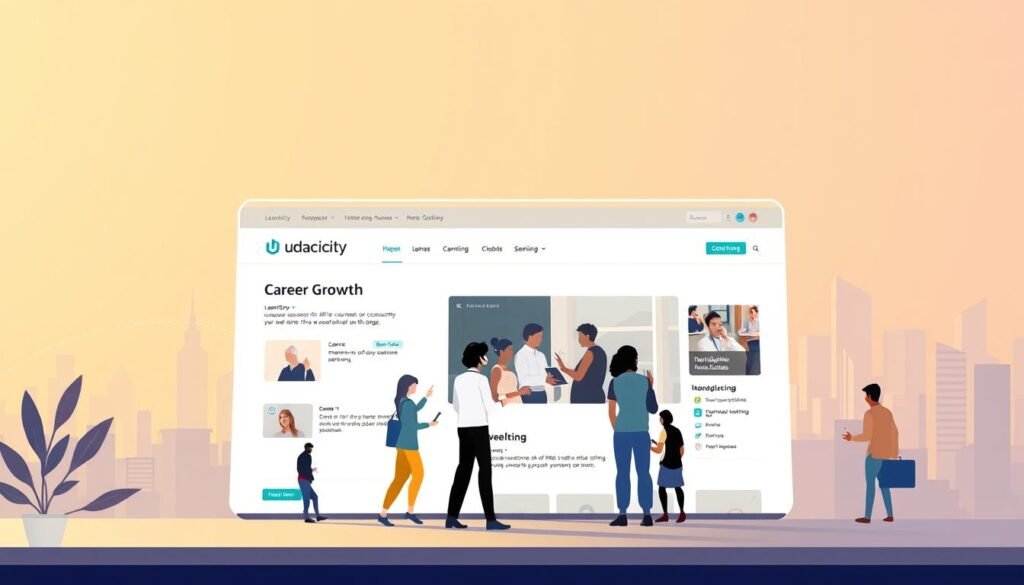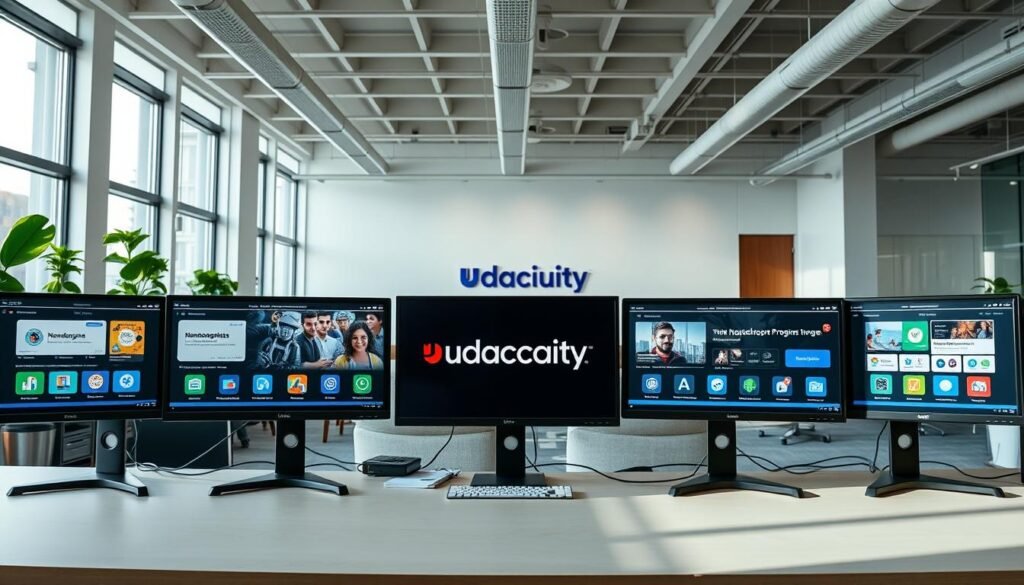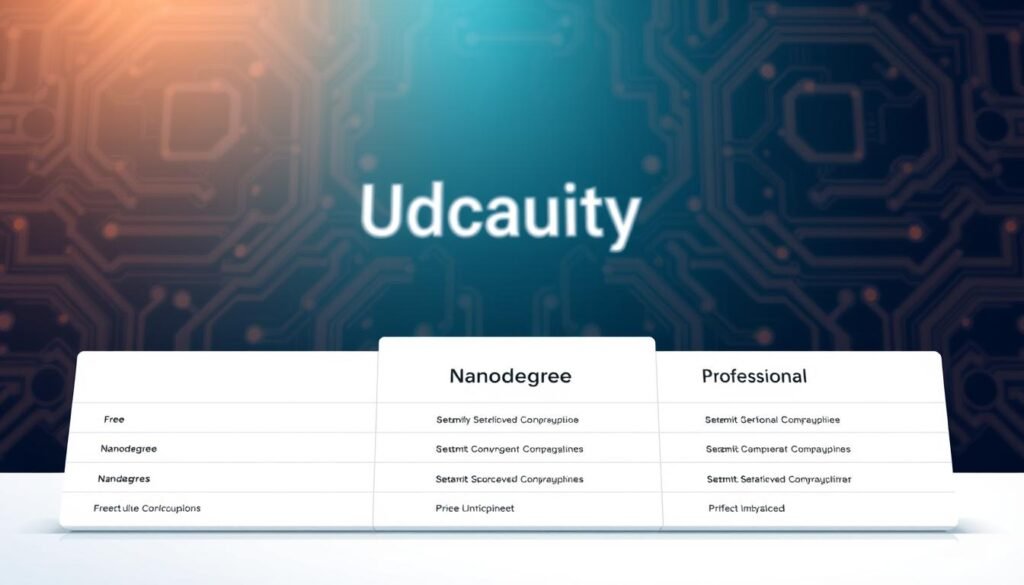Ever wondered how professionals stay ahead in fast-changing tech fields? The answer lies in online learning platforms that bridge skill gaps with industry-aligned courses. Udacity, founded in 2011 by Sebastian Thrun and partners, has become a leader in this space.
With 17 million users globally, Udacity offers Nanodegree programs designed for career growth. Its recent acquisition by Accenture in 2024 boosted AI-powered learning features. Students gain job-ready skills through courses in data science, programming, and artificial intelligence.
What sets this platform apart? Strong partnerships with tech giants ensure curriculum relevance. Whether you’re upskilling or switching careers, Udacity provides structured paths to success.
Key Takeaways
- Founded in 2011, acquired by Accenture in 2024
- Serves 17 million students worldwide
- Focuses on tech skills like AI and data science
- Offers career-oriented Nanodegree programs
- Features industry partnerships for relevant curriculum
Introduction to Udacity
How did a Stanford experiment transform into a global career accelerator? Originally offering free computer science courses, this company pivoted in 2013 to focus on vocational training. Today, it’s a leader in online education, helping learners bridge skill gaps with industry-aligned programs.
Udacity’s success stems from collaborations with tech giants like Google and IBM. Over 78 Nanodegree programs were co-created with partners, ensuring content stays relevant to employer needs. Real-world projects and simulations let students “learn by doing”—a core differentiator.
The platform caters primarily to working professionals seeking advancement in tech fields. With learners in 203 countries, 42% are based in the United States. This global reach underscores its role in democratizing high-quality technical training.
History and Background of Udacity
Innovation in tech education started with one bold experiment in 2011. Stanford professor Sebastian Thrun launched a free AI course, attracting 160,000 students worldwide. This proved the demand for accessible higher education in tech fields.
Founding and Early Years
By 2013, the platform pivoted from academic courses to vocational training. The focus shifted to job-ready skills like programming and data science. A landmark partnership with Georgia Tech in 2014 introduced a $7,000 online computer science master’s degree—a game-changer for affordable higher education.
Recent Developments
In 2018, Udacity expanded into AR/VR training through a collaboration with Unity. The 2021 spin-off Voyage was acquired by Cruise, showcasing its impact on autonomous tech. The biggest changes came in March 2024, when Accenture acquired the platform to boost corporate training capabilities.
Udacity Course Offerings and Nanodegree Programs
What makes Udacity’s learning approach stand out in the competitive tech education space? Its Nanodegree programs blend structured curricula with real-world projects, ensuring learners gain job-ready skills. With 78 specialized tracks, these courses cater to fields like AI, cybersecurity, and data science.
Nanodegree Programs
Each program spans four months, requiring 10–15 hours weekly. Learners tackle Python-based coding exercises, video lectures, and peer-reviewed projects. Specializations like the Self-Driving Car Engineer Nanodegree program include asteroid-tracking simulations for hands-on practice.
Free Courses vs. Paid Programs
While free classes offer foundational knowledge, paid programs provide certifications and mentor support. The $249/month subscription includes career services, making it ideal for professionals seeking advancement.
Course Format and Learning Experience
Video lessons are paired with interactive quizzes and real-world scenarios. The focus on portfolio-ready deliverables ensures learners graduate with tangible proof of their skills. This format bridges the gap between theoretical knowledge and employer expectations.
Benefits of Udacity for Career Growth
Career advancement in tech demands more than just experience—it requires proof of expertise. The platform’s Nanodegree programs deliver measurable career outcomes, with 89% of graduates reporting positive job impacts. From skill validation to employer connections, learners gain competitive edges in high-demand fields.
Industry-Relevant Skills
Employers prioritize candidates with hands-on skills in AI programming and cloud computing. Courses teach real-world applications like AWS deployment and Python-based data visualization. These competencies align with needs at IBM, Google, and other industry leaders.
Certification and Resume Building
Pearson VUE-proctored exams validate certificate credibility, making credentials stand out to recruiters. Career services include LinkedIn optimization and GitHub portfolio reviews. Over 42% of students secure interviews within three months of completing programs.
Success Stories
AT&T actively recruits from Udacity’s talent pool for internship programs. Alumni at NASA and Google report average salary increases of $24,000 post-certification. These outcomes demonstrate how tech training translates into tangible career growth.
Pricing and Subscription Plans
Budgeting for professional development? Udacity’s flexible plans cater to diverse financial needs. Learners can choose between a $249/month subscription or a discounted $846 prepaid option for four months. This structure balances affordability with commitment, ideal for fast-paced upskilling.
Cost of Nanodegrees
The Nanodegree programs offer tiered pricing to match career goals. Enterprise plans for company teams include bulk discounts and customized learning paths. A 7-day free trial lets students test-drive courses before committing.
Financial Aid and Scholarships
Over 50,000 Google scholarships have made these programs accessible. Need-based aid and income share agreements further reduce barriers. Partnerships with Microsoft and others expand opportunities for underrepresented groups in tech.
Alternatives to Udacity
Tech education isn’t one-size-fits-all—here’s how rivals compare. While Udacity specializes in tech-focused Nanodegrees, other platforms cater to broader subjects or academic credits. Choosing the right fit depends on career goals, budget, and learning style.
Udemy: Breadth Over Specialization
With 130,000+ courses, Udemy leads in variety. Topics range from business analytics to photography, appealing to casual learners. However, its open-instructor model lacks the structured career paths of Udacity’s industry-vetted classes.
Prices start at $25 per course, but quality varies. Certificates hold less weight with employers compared to Nanodegrees.
Coursera: Academic Partnerships
Coursera partners with universities, offering credits toward degrees. Its platform suits learners seeking formal education in business or humanities. However, tech courses often prioritize theory over hands-on projects.
Subscriptions cost $59/month, with financial aid available. Unlike Udacity, Coursera’s certificates include university branding.
Treehouse: Coding-Centric Approach
Treehouse focuses exclusively on coding, ideal for beginners. Its classes cover web development and mobile apps but lack advanced AI or data science tracks. The $25/month plan includes quizzes but fewer real-world projects.
For career-changers, Udacity’s depth and mentorship outperform Treehouse’s bootcamp-style format.
Conclusion
Tech careers evolve fast—staying ahead requires the right training. Udacity’s platform delivers with industry-backed courses and a 93% satisfaction rate. Students gain hands-on skills through projects vetted by partners like AWS and Facebook.
For career changers, the ROI is clear: measurable career growth and 300+ hiring connections. Whether upskilling or pivoting, this model works.
Try a free course to experience the format. With Accenture’s resources, expect even more AI-driven learning tools soon.
FAQ
What types of courses does Udacity offer?
The platform provides industry-focused programs, including Nanodegrees in tech fields like artificial intelligence, data science, and programming. They also offer free introductory courses alongside paid career-track programs.
How do Nanodegree programs differ from free courses?
Nanodegrees are structured, mentor-supported programs with hands-on projects, graded assignments, and career services. Free courses provide foundational knowledge but lack certifications or job-ready skills.
Are Udacity certificates recognized by employers?
Yes. Certificates from Nanodegree programs are valued by tech companies like Google and IBM, as the curriculum is co-created with industry leaders to match job market demands.
What is the average cost of a Nanodegree?
Prices range from 9 to 9 per month, depending on the program length. Financial aid and scholarships are available for eligible learners.
Can Udacity help with job placement?
While not a guarantee, they offer career services like resume reviews, LinkedIn profile optimization, and access to employer networks through their talent partnerships.
How long does it take to complete a Nanodegree?
Most programs take 3–6 months with 10–15 hours of weekly study. Self-paced options allow flexibility for working professionals.
Does Udacity offer refunds?
Yes. A 7-day refund policy applies to Nanodegrees if you haven’t accessed graded content. Free courses are non-refundable as they’re cost-free.
Are there alternatives to Udacity for tech education?
Competitors like Coursera, Udemy, and Treehouse offer similar courses, but Udacity stands out with its project-based learning and industry-aligned Nanodegrees.









